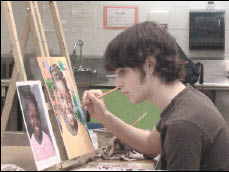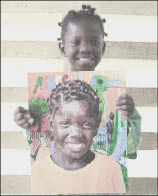Madison, Wis.
(608) 467-5706
www.thememoryproject.org
 |
|
Lead Rosenblith painted a portrait of a girl named … Photo: The Memory Project |
Objective: To develop caring among youth in different countries through meaningful exchanges of art.
In a Nutshell: Each year, the Memory Project enlists thousands of high school art students to create portraits, using photos of orphaned children from around the world. The completed portraits are returned to the children, who are encouraged to create and send back their own drawings to the art students.
When It Began: The Memory Project was founded in October 2004 in partnership with 15 high school art teachers.
Youth Served: More than 5,000 high school juniors and seniors enrolled in advanced art classes participate each year. Since its inception, the project has sent more than 20,000 portraits to children living “in orphanages, shelters for street children and other facilities serving youth who have been abandoned, orphaned, abused and neglected,” according to founder and director Ben Schumaker.
 |
|
… Maseray, who happily received it in Sierra Leone. Photo: The Memory Project |
Where it Happens: The art students represent nearly every state. Portraits have been distributed to children and youth in more than 30 countries in Central and South America, Eastern Europe, Africa and Asia.
Who Started It and Who Runs It: Schumaker founded the program while he was a graduate student in social work at the University of Wisconsin. His inspiration came during a volunteer trip to Guatemala, when a man who had grown up in an orphanage talked about having no personal belongings from his youth. The project was designed to “contribute to [the children’s] sense of identity and personal self-worth,” Shumaker said.
Schumaker is the program’s sole staff member. He coordinates with high school art teachers, contacts orphanages and oversees the distribution of the portraits.
Overcoming Obstacles: The unique nature of the Memory Project meant that no similar programs existed to serve as a guide in the early years. Also, in order to ensure that every child in a participating facility receives a portrait, two art students paint a portrait of the same child (in case one does not get finished on time.)
Cost: The yearly operating budget is approximately $75,000.
Who Pays: High schools pay a $15 participation fee per student, which accounts for nearly all the program’s funding. The program has also received several individual donations in the $5,000 to $10,000 range.
Youth Turn-On: “Kids at the orphanage usually love their portraits, if for no other reason than they have so few personal keepsakes to call their own,” Schumaker said. U.S. students enjoy receiving responses from the children and seeing photos of their smiling subjects in distant countries with their portraits in hand.
Youth Turn-Off: “Sometimes kids at the orphanages, teenagers in particular, are understandably turned off by unflattering portraits,” Schumaker said. American art students are often disappointed when they do not get a response from a child.
Research Shows: Surveys conducted by the Memory Project of participants in the U.S. and at overseas facilities show that an overwhelming majority of children and youth say the program is a positive experience.
What Still Gets in the Way: Despite the Memory Project’s request that only “highly advanced art students” participate, some unskilled students still sign up. The resulting portraits are “sometimes questionable in the eyes of the children who receive them,” Schumaker said.
Contact: Ben Schumaker, program founder and director, (608) 467-5706, www.thememoryproject.org.

























